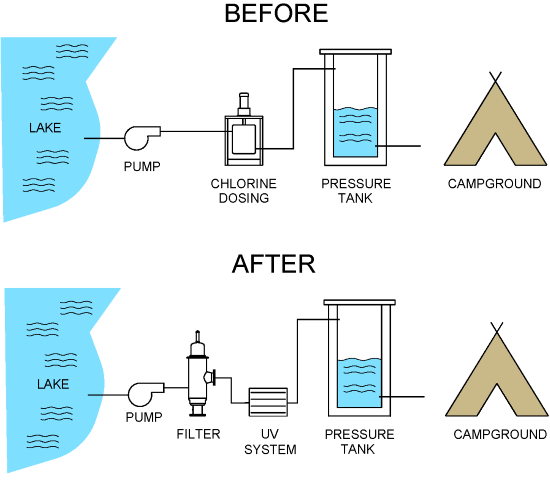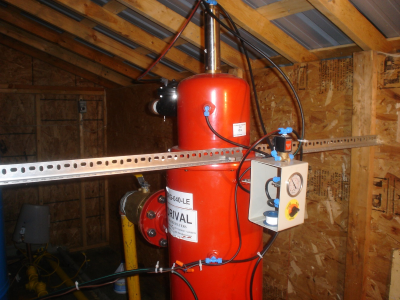Self-Cleaning Filters Enable Campground to Eliminate Chlorination in Drinking Water
Feb 2023, Carl Tolsma, Owner, Stanley Park Campground
Welcome sign to the 110 acre Stanley Park Campground in Manitoulin Island, Ontario, Canada.

Before and after schematic of the campground's water supply.

The ORG's small footprint allowed the park to install the filter in a small, tight area in its maintenance room.
Stanley Park Campground is a popular Manitoulin Island summer getaway and retreat. The park has 230 fully serviced sites as well as 3 community bathroom and shower areas. The park can see upwards of 1000 people a day in the hot summer months, from daily campers to long term retiree summer residents.
For their water supply, Stanley Park would pump water at 65 GPM directly from Lake Mindemoya, chlorinate it and store it in pressure vessels for consumption.
While this method withstood the park's stringent, monthly water quality testing, chlorination was proving to be a time-consuming, labor-intensive process. In addition, management didn't like the threat of a dangerous chlorine spill looming in their campground. The park needed a maintenance-free solution that would also live up to their rigorous water quality testing.
In January of 2008 park management started to investigate alternatives to chlorinating the water. A UV system was proposed in place of the chlorination. While the UV system alleviated the issues associated with chlorination, their water system would now be more vulnerable to particulates in the water, especially at certain times of the year when the particle count of debris would rise for various reasons. Particles in the water damage UV bulbs, thereby increasing the frequency with which management would need to change them. To successfully protect UV bulbs, water must be filtered down to 5 microns, or 0.0002 inches. This led management to look for a solution to reduce the amount of particulates in the water down to 5 microns, while also requiring little maintenance.
Park management contacted Orival. Orival's filters come with screens ranging in size from 3000 to 5 microns and can filter particulates independent of their specific gravity. Orival's filters are also self-cleaning, so management wouldn't need to deal with the same high-maintenance headaches that were associated with chlorination.
Initially, a pilot was set up with 2 ORG-015-LE units, each having a screen area of 64 in 2 . However, due the relatively fine level of 5 micron filtration required by the application, more screen area was required. So ultimately, an ORG-040-LE unit with 700 in 2 of screen area was chosen.
“We have some of the cleanest water available and have got rid of the expense and handling of large amounts of chlorine.”
Today, the park's water quality is higher than when chlorine disinfection was used; Stanley Park got the added bonus of removing particulates down to 5 microns from their water supply line. The park owner boasts: “We have some of the cleanest water available and have got rid of the expense and handling of large amounts of chlorine. Our filter has run great with very little maintenance and expense.”